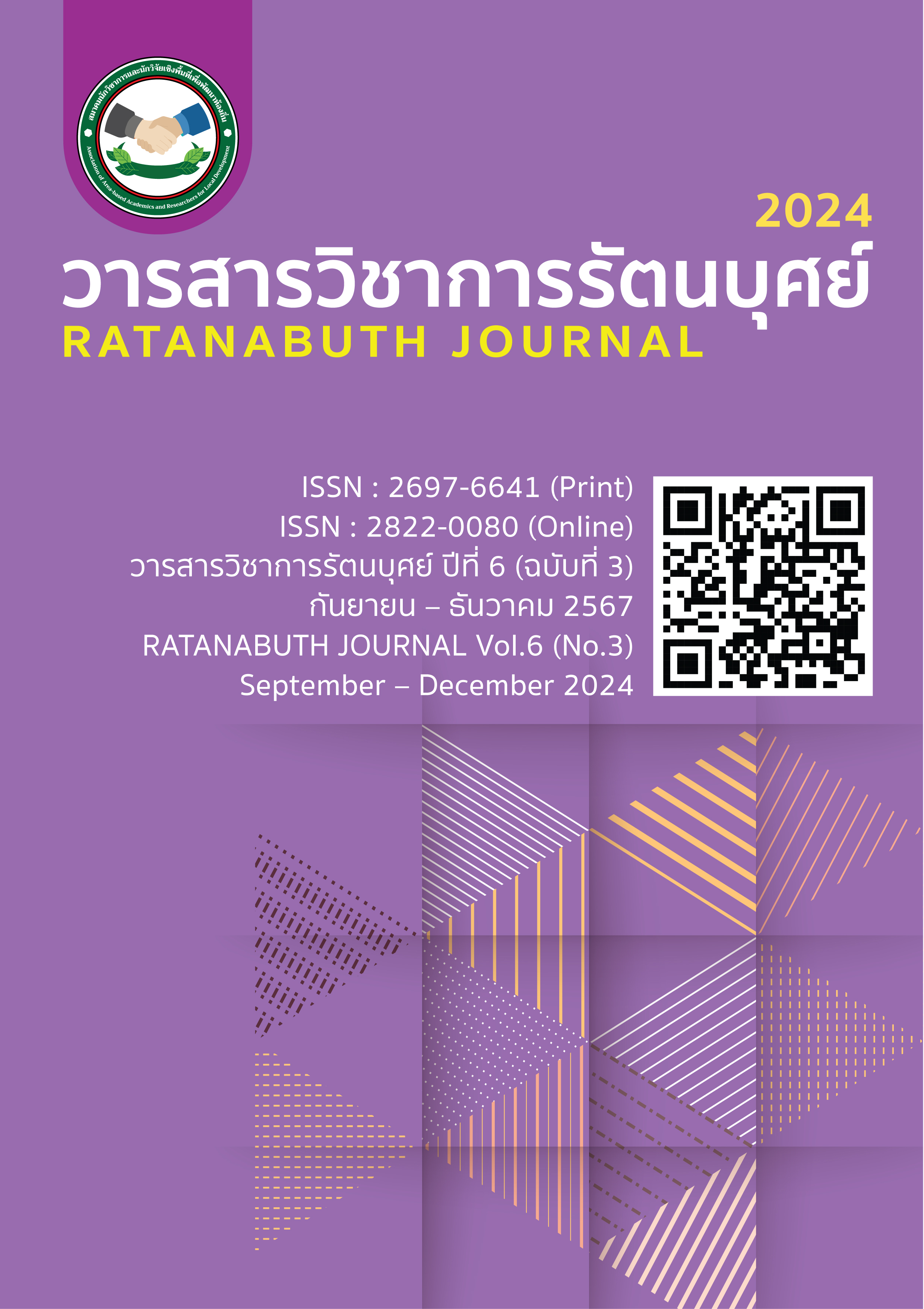องค์ประกอบของการเปลี่ยนผ่านสู่เศรษฐกิจหมุนเวียนสำหรับธุรกิจขนาดกลางและขนาดย่อม Elements of the transition to a circular economy for SMEs
Main Article Content
บทคัดย่อ
เศรษฐกิจหมุนเวียนส่งผลต่อมูลค่าโอกาสทางเศรษฐกิจถึง 4.5 ล้านล้านดอลลาร์โดยการลดของเสีย กระตุ้นการเติบโตของธุรกิจและสร้างงาน ดังนั้นการเปลี่ยนผ่านสู่ระบบเศรษฐกิจหมุนเวียนจะสามารถเพิ่มผลผลิตและการจ้างงานของประเทศไทยได้ โดยจะทำให้ GDP เพิ่มขึ้นประมาณร้อยละ 1.2 โดยเฉพาะธุรกิจ SMEs การวิจัยครั้งนี้มีวัตถุประสงค์เพื่อศึกษาความสำคัญในแต่ละองค์ประกอบของตัวแปรด้านแรงกดดันทางสังคม ประสิทธิภาพทางเศรษฐกิจ ประสิทธิภาพทางเศรษฐกิจ และเศรษฐกิจหมุนเวียน ใช้การวิเคราะห์องค์ประกอบเชิงยืนยันเก็บข้อมูลจากผู้ประกอบธุรกิจขนาดกลางและขนาดย่อมในเขตกรุงเทพและปริมลฑล จำนวน 400 ราย เครื่องมือที่ใช้ในการวิจัยแบบสอบถาม ผลการทดสอบค่าความสอดคล้องแล้วมีค่าระหว่าง 0.80-1.00
ผลการวิจัย พบว่า ความสำคัญของตัวแปรสังเกตจากมากไปน้อยได้ดังนี้ มีการนำของเสียที่เกิดขึ้นในกระบวนการผลิตถูกนำไปรีไซเคิล (CE5) กิจการของท่านคำนึงถึงความใส่ใจต่อสิ่งแวดล้อมที่อาจเกิดขึ้นของผลิตภัณฑ์และกระบวนการผลิต (EN1) รัฐบาลให้เงินอุดหนุนและสิทธิประโยชน์ทางภาษีสำหรับการดำเนินการตามแนวทางเศรษฐกิจหมุนเวียน (Econ1) และอุตสาหกรรม/ผู้ซื้อโดยตรงพร้อมที่จะจ่ายส่วนต่างทางการตลาด (Econ2) มีความสำคัญเท่า ๆ และ ตลาดยืนยันที่จะผลิตสินค้าราคาไม่แพงโดยลดผลกระทบต่อสิ่งแวดล้อมให้น้อยที่สุด (SP1) ผลการตรวจสอบดัชนีวัดความสอดคล้องของตัวแปรแฝงทั้ง 4 องค์ประกอบโดยรวมพบว่ามีค่า X2 มีค่าอยู่ระหว่าง 266.76 – 973.56 มีค่า X2/ df มีค่า 1.65 - 2.00 ผ่านเกณฑ์ที่กำหนดที่ต้องมีค่าน้อยกว่า 2.00 ค่า P-value ผ่านระดับที่ยอมรับได้ ค่า CFI, NFI, GFI และ AGFI มีค่าระหว่าง 0.98-0.99 ผ่านเกณฑ์ที่กำหนดคือมีค่ามากกว่า 0.90 และค่า RMR, RMSEA มีค่าระหว่าง 0.050-0.058 ผ่านเกณฑ์ตามที่กำหนดเช่นกัน
ข้อเสนอแนะนำของเสียที่เกิดขึ้นในกระบวนการผลิตนำไปรีไซเคิล ช่วยลดค่าใช้จ่าย ลดปัญหาด้านสิ่งแวดล้อม ลดปัญหาด้านเงินลงทุนได้ รวมถึงการสร้างความแตกต่างในตัวสินค้าหรือบริการจึงเป็นสิ่งที่จำเป็น สร้างรูปแบบผลิตภัณฑ์ใหม่ ๆ ที่แตกต่างเพื่อก่อให้เกิดความได้เปรียบและการสร้างมูลค่าเพิ่มให้แก่ผลิตภัณฑ์และ ปลอดภัยต่อผู้บริโภค
Article Details

อนุญาตภายใต้เงื่อนไข Creative Commons Attribution-NonCommercial-NoDerivatives 4.0 International License.
เอกสารอ้างอิง
นงลักษณ์ วิรัชชัย.(2542). แบบจำลองลิสเรล: การวิเคราะห์ทางสถิติเพื่อการวิจัย. กรุงเทพฯ: โรงพิมพ์จุฬาลงกรณ์มหาวิทยาลัย.
ปริญญา สารทอง.(2566).พฤติกรรมและปัจจัยส่วนประสมทางการตลาดที่มีผลต่อการตัดสินใจซื้อสินค้า. เป็นมิตรต่อสิ่งแวดล้อมสำหรับผู้บริโภคในกรุงเทพมหานคร. วารสารราชภาคย์, 17(52), 404-415.
ภัทรพล ชุ่มมี. (2566). การพัฒนากรอบแนวคิดสมการโครงสร้างสำหรับเศรษฐกิจหมุนเวียนในธุรกิจขนาดกลางและขนาดย่อม. วารสารวิชาการร้อยแก่นสาร, 8(6), 281-295.
สุชาติ ประสิทธิ์รัฐสิทธ์. (2544). วิธีการวิจัยทางสังคมศาสตร์. กรุงเทพฯ: สำนักพิมพ์เฟื่องฟ้า.
สำนักงานบริหารนโยบายนายกรัฐมนตรี.(2565). เศรษฐกิจหมุนเวียน. สำนักงานบริหารนโยบายนายกรัฐมนตรี.
สำนักงานส่งเสริมวิสาหกิจขนาดกลางและขนาดย่อม (SME). (2565).จำนวนผู้ประกอบการ. สืบค้นเมื่อ 8 ธันวาคม 2565. จาก: https://www.sme.go.th/th/?.
ฝ่ายเศรษฐกิจและศูนย์ข้อมูลหอการค้าไทย. (2561). เศรษฐกิจหมุนเวียน. สืบค้นเมื่อ 17 พฤศจิกายน 2565. จาก https://www.thaichamber.org/content/file/document/09061 81536224841.pdf.
Arranz, C. F., & Arroyabe, M. F. (2023). Institutional theory and circular economy business models: The case of the European Union and the role of consumption policies. Journal of Environmental Management, 340, 117906.
Brown, T. (2015). Confirmatory factor analysis for applied research. New York, NY: The Guilford press.
Centobelli, P., et., al. (2021). Determinants of the Transition Towards Circular economy in SME: A sustainable supply chain management perspective. International journal of production economics. 242: 108297.
Cheffi, W., Zahir-ul-Hassan, M. K., Farooq, M. O., Baqrain, A., & Mansour, M. M. H. (2023). Ethical leadership, management control systems and circular economy in SMEs in an emerging economy, the UAE. Journal of Business Research, 156, 113513.
Dey, P., et., al. (2022). Adoption of circular practices in small and medium-size enterprises: Evidence from Europe. International Journal production economics. 248: 108496.
Fogarassy, C., & Finger, D. (2020). Theoretical and practical approaches of circular economy for business models and technological solutions. Resources, 9(6), 76.
Hair, J. F., Black, W. C., Babin, B. J., & Anderson, R. E., (2010). Multivariate data analysis: A global perspective. Upper, Saddle River, NJ: Pearson Education, International.
Hair, J. F., Anderson, R. E., Talham, R. L., & Black, W. C. (1998). Multivariate data analysis (5th ed.). Upper Saddle River, NJ: Prentice-Hall.
Helander, H., et., al. (2019). How to monitor environmental pressures of a circular economy: An assessment of indicators. Industrial ecology. 23(5): 1001-1310.
Jöreskog, K. G., & Sörbom, D. (1993). LISREL 8: Structural equation modeling with the SIMPLIS command language. Scientific Software International.
Khan, S., et., al. (2022). Technological revolution and circular economy practice practices: A mechanism of green economy. Sustainability. 14: 4524.
Marrucci, L., Daddi, T. and Iraldo, F. (2022). The circular economy, environmental performance and environmental management systems: the role of absorptive capacity. Journal of Knowledge Management. 26(8): 2107-2132.
Mueller, R., and Hancock, G. (2001). Factor analysis and latent structure, confirmatory. International encyclopedia of the social & behavioral sciences. 5239-5244.
Nunnally, J. (1978). Psychometric methods. New York: McGraw-Hill.
Ren, Q., & Albrecht, J. (2023). Toward circular economy: The impact of policy instruments on circular economy innovation for European small medium enterprises. Ecological Economics, 207, 107761.
Shamil, M. M., SHAIKH, J. M., HO, P., & KRISHNAN, A. (2022). External Pressures, Managerial Motive and Corporate Sustainability Strategy: Evidence from a Developing Economy. Asian Journal of Accounting & Governance, 18.
Sohal, A. and Vass, T. (2022). Australian SME's experience in transitioning to circular economy. Journal of business research, 142: 594-604.
Statista. (2022). Micro, small, and medium enterprise (MSME). Retrieved November 18, 2023. From https://www.statista.com/statistics/1337348/thailand-msme-output-as-a-share-of- gdp/#statisticContainer.
Steiger, J. H. (1990). Structural model evaluation and modification: An interval estimation approach. Multivariate Behavioral Research, 25(2), 173-180.
Singh, M.P., Chakraborty, A., Roy, M. (2018). Developing an extended theory of planned behavior model to explore circular economy readiness in manufacturing MSMEs, India. Resour. Conserv. Recycl. 135: 313–322.
The Japantime. (2022). Japan aims to expand size of circular economy. Retrieved November 17, 2023. From https://www.japantimes.co.jp/news/2022/08/27/business/japan-circular-economy-expansion/.
Vidal-Ayuso, F., Akhmedova, A., & Jaca, C. (2023). The circular economy and consumer behaviour: Literature review and research directions. Journal of Cleaner Production, 137824.
World Bank. (2022). The circular economy is the key to helping Thailand recover resiliently. Online. Retrieved November 17, 2022. From: https://www.worldbank.org/th/news/press-release/2022/06/29/circular-economy-key-to-supporting-thailand-s-resilient-
World economic Forum. (2022). Circular Economy. Retrieved November 17, 2022. From: https://www.weforum.org/agenda/2021/01/why-middle-income-countries-should-embrace-circular-economy/.


